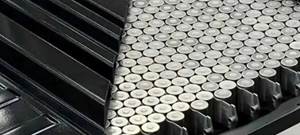New Technology and Composites
With new technology sweeping into business from every avenue, simply keeping up sometimes feels overwhelming. Lets see - there's checkless banking, electronic inventory control, product data and life cycle management, CAD/CAM and CAE, paperless engineering, automated process control, Internet data exchange, online
With new technology sweeping into business from every avenue, simply keeping up sometimes feels overwhelming.
Lets see - there's checkless banking, electronic inventory control, product data and life cycle management, CAD/CAM and CAE, paperless engineering, automated process control, Internet data exchange, online purchasing, e-mail, instant messaging and Web site development and administration - to mention just of the few of the technologies that will make us more efficient. And they are making us more efficient. That's one of the reasons we have so many unfilled jobs in the U.S. right now. In 1965, Intel cofounder Gordon Moore stated that computer speed would double every 18 months. Now known as Moore's Law, that axiom is predicted to hold true through this decade. I don't know whether to rejoice or retire!
Nevertheless, one can't help but wish that the volume of composite material usage would increase at something like that rate. Isn't it tiresome telling newcomers to the industry not to expect "revolution" in composites, but to expect "evolution" instead?
Granted, introducing to the world a brand-new material, with attendant design considerations, is not an easy task. Look how long it took aluminum to be accepted for automotive applications. And composite materials have their own tricky issues, of course - getting the string into the glue fast has been problematic and, unlike with composites, when using steel, aluminum or wood, you don't have to design the material as you go along.
But I can't help thinking that the composites industry is going to grow at a faster rate than most other industries over the next few years. In the article on p. 20, composites use in Asia - already accounting for 30 percent of global production, is expected to grow at 7 percent annually in the coming years. This is largely based on low-cost industrial applications, where composites are replacing metal parts.
In our wind energy news (p. 14, Irish offshore wind park and U.S. wind farms), we lay out the companies and wind farm projects that are coming in the remainder of this year. Wind power is nearing or at parity with natural gas in terms of cost per kilowatt/hour. This market is indeed booming. And new designs and lighter hybrid materials are predicted to make wind-blade manufacture faster and ultimately even less expensive. So there's no end in sight.
Core suppliers are creating a multitude of new core materials in a constant race to facilitate larger, more performance-driven and process-enabling shapes and forms. Our overview article on p. 24 discusses what's available.
Since this October issue of Composites Technology will go to the International Boat Exposition in Miami, Fla., U.S.A. (Oct 27-29), it's fitting that the remaining articles explore marine composites. In Inside Manufacturing on p. 34, we discuss how an old Dutch boatbuilder used a simplified vacuum infusion process to manufacture its large yachts both cost-effectively and cleanly. Engineering Insights (p. 44) discusses a brand new process that enables a thermoformed shell made from a multilayer extruded sheet to replace gel coat in marine and other applications.
All of these articles underscore the ways suppliers are making it easier and cheaper to use composite materials and successfully design and manufacture the parts made with them. We are taking market share from conventional materials in many markets, and materials manufacturers are constantly improving their products. Business may not be doubling every 18 months, but it seems to me we're getting a great deal of work done, and doing it about as fast as we can.
Related Content
Honda begins production of 2025 CR-V e:FCEV with Type 4 hydrogen tanks in U.S.
Model includes new technologies produced at Performance Manufacturing Center (PMC) in Marysville, Ohio, which is part of Honda hydrogen business strategy that includes Class 8 trucks.
Read MoreComposites end markets: Batteries and fuel cells (2024)
As the number of battery and fuel cell electric vehicles (EVs) grows, so do the opportunities for composites in battery enclosures and components for fuel cells.
Read MorePolar Technology develops innovative solutions for hydrogen storage
Conformable “Hydrogen in a Box” prototype for compressed gas storage has been tested to 350 and 700 bar, liquid hydrogen storage is being evaluated.
Read MoreCeramic matrix composites: Faster, cheaper, higher temperature
New players proliferate, increasing CMC materials and manufacturing capacity, novel processes and automation to meet demand for higher part volumes and performance.
Read MoreRead Next
Scaling up, optimizing the flax fiber composite camper
Greenlander’s Sherpa RV cab, which is largely constructed from flax fiber/bio-epoxy sandwich panels, nears commercial production readiness and next-generation scale-up.
Read MoreNext-gen fan blades: Hybrid twin RTM, printed sensors, laser shock disassembly
MORPHO project demonstrates blade with 20% faster RTM cure cycle, uses AI-based monitoring for improved maintenance/life cycle management and proves laser shock disassembly for recycling.
Read MoreCeramic matrix composites: Faster, cheaper, higher temperature
New players proliferate, increasing CMC materials and manufacturing capacity, novel processes and automation to meet demand for higher part volumes and performance.
Read More








